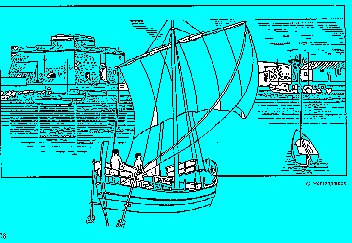


 [GO TOP]
[GO TOP] 
Hellenic of old, since the time of Praxander, its founder, Kyrenia is now occupied but not a slave, holding in its castle, as a megalithic companion, the ancient ship of Kyrenia.
A Greek merchant vessel of the 4th century B.C, with a captain and three sailors, the ship had traversed the entire Mediterranean before it sank off the shores of Kyrenia around 300 B.C. There, on the seabed, it remained until 1965, when Kariolou discovered it and archaeologists completely restored it.
The shipwreck of Kyrenia, a bridge that fills the gap between Homeric and Hellenistic times, occurred with a harsh whim of fortune, sharing the fate of Hellenism in Cyprus.
The Greek ship of Kyrenia, one of the innumerable vessels aboard which, for thousands of years, Hellenism has incessantly been sailing from the "shores of Homer" "for exploration" and "trade", ultimately found itself captive in the entrenchments of Attilla.
The ship was replicated in the shipyard of Psarros at Perama. The replica of its wood, brought to life by the able shipbuilders, the captain and its crew, sailed off from Pireus and followed the ancient route before reaching Paphos. It was launched in the waters of Salamis and travelled towards the place where "there is an Island", where ancient pictures have "as a mosaic in their eyes the bitter pain of Greece". Hellenism welcomes it in the way it has been waiting for ages.
Our thanks go to those who have contributed to this exemplary effort.
Our expectations converge with the secret voices that span distances and constitute the word and myth of the Nation.
Welcoming "Kyrenia II" we welcome our history, tradition and civilization.
And welcoming our past we see into our future.
 [GO TOP]
[GO TOP] 
On behalf of the board of trustees of H.I.P.N.T [Hellenic Institute for the Protection of Nautical Tradition], the
crew, the scieritists who have accompanied the ship and all those who worked hard to bring this voyage about, I wish to express our heart-felt thanks for the warm welcome we are receiving today.
I am deeply moved. I visualized this moment four years ago, when my colleagues and I began the building of this ship.
With the "Kyrenia II" Experimental Archaeology programme we have managed to fill many gaps in our knowledge of ancient shipbuilding and the journeys of ancient ships. We sailed across the Aegean, arrived at Kos and from there we followed the route of the last journey of the ancient ship of Kyrenia. On the small island of Ro, next to the grave of the lady of Ro, we hoisted the Greek flag, as this great Greek lady used to do for decades. We planted an olive tree, a symbol of peace, that was given to us by the Minister of Culture when we started our journey. And now we have arrived in Cyprus and we are overjoyed.
At this happy and moving hour our thoughts should be with the man who discovered the ancient Greek ship of Kyrenia, Andreas Kariolou, who unfortunately is not with us now. We dedicate the journey we have made to his memory, to the memory of the man who loved the sea, Kyrenia and Cyprus. Andreas Kariolou left us grieving because he didn't live to see his beloved Kyrenia free. Today we give a pledge that we will not lay up "Kyrenia II" until the day when the flag of liberty flies over the castle of Kyrenia. And this day will come. And then we will come again on "Kyrenia II", we will return and enter the free harbour of Kyrenia, with the same crew, the same captain, Antonis Vassiliades, and Andreas's son Glafkos Kariolou. Until then this ship will not stop crossing the oceans from East to West, carrying the message that here are men who do not compromise, who persist in the struggle for liber- ation, who do not forget.
We cannot do more with this merchant ship, with this small ship, with this ship of peace.
 [GO TOP]
[GO TOP]
 Go to the previous page
Go to the previous page